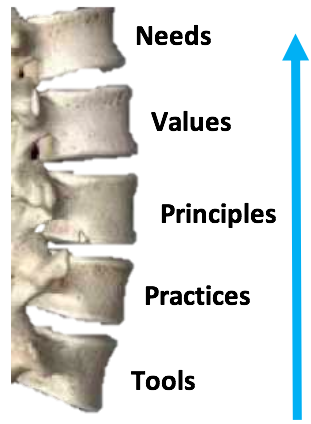My introduction to Agile came at my last job, where we underwent an Agile transformation using Scrum in a knowledge work setting. During the culture change, I went from “Developer” (I use quotes because we were not building software) to Scrum Master and eventually Assistant Agile Coach for the department. As the Assistant Coach, I worked primarily with two director-level individuals and I often clashed with one (I think he would corroborate my story). Let’s call him Pete.
What Are We Doing Here?
Pete and I had a good relationship outside of work. We would frequently chat and joke around; we went running together in the mornings, and there was certainly no hostility between us personally. While at times heated, our work-related conversations were honest and productive, even if we had trouble getting aligned. One afternoon, while discussing some of the trouble spots on one of the Scrum teams, Pete paused for a minute and asked, “What are we doing here? I mean… what really are we doing here?”
The question could have been interpreted in a multitude of ways. What were he and I really discussing in his office? What were we as humans doing on this planet? The possibilities were endless. But I knew what he meant: what are the needs of our department? Or, more simply, why do any of the Scrum teams in our department exist? It pains me to do it, but I have to hand it to Pete. That afternoon in his office, he hit on something big: the importance of the why behind the what.
Needs
As I get more opportunities to help teams and coach organizations during my career, I hope that I can always keep the needs of those I am helping in mind. That perspective is a perfect segue into the Spine Model. It proposes a spine made up of 5 vertebrae: Needs, Values, Principles, Practices, Tools.
The vertebrae are arranged—from top to bottom—from most important to least important. The spine brings focus to the idea that we can adjust the bottommost elements frequently, but we should put a lot of thought into the top elements and keep them relatively static.
The first thing any team should identify is to address their existence, the “What are we doing here?” or “Why are we here?” questions. Maybe they exist to serve a client and deliver whatever the client requests. Maybe they exist to advise a client and champion that client’s best interests, shaping requests as necessary. If the team is part of a lean startup, the need might be to deliver the best possible experience for an end user. These specifics will differ, but the principle remains: first determine the need the team will address, and build the rest of the spine around it.
Going Up the Spine
Every decision we make about any element of the spine should be driven by the levels above. If we are selecting a tool—JIRA for example—we should ask whether that tool is the best one to support our chosen practice (Scrum, perhaps?). If we are choosing a practice, does that practice support the principles we want to uphold? Do our principles support our values? And do our values still support the client’s needs, the reason our team exists in the first place? We must continuously evaluate these questions to ensure our team’s spine is properly aligned. If our needs change, we will likely want to reevaluate all of the other vertebrae as well.
Team Agreement
My current team is in the process of coming up with a working agreement (a list of team norms) and I think the Spine Model is particularly relevant. What I’d like my team to start with are questions around why we exist and what we value. Next, I want us to consider our practices and tools. I am 100% open (and I try to make this explicit with my team) to frequently changing our practices and tools if we feel there are better ways to serve our principles, values, and needs.
Closing
The Spine Model conceptualizes the foundations of a team. When we get bogged down in the lesser aspects of work, we exhaust ourselves. Quarrels over details of tooling and practices often have their root in disagreements about values, principles, or even needs. Seek alignment on those most important aspects first. Create a solid foundation; straighten the spine. This model is a useful tool for thinking about and communicating how to do this; it focuses us on what is important.